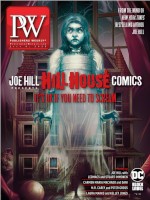One of the biggest “first-world problems” to arise during 2020’s necessary isolation in response to Covid-19 has to do with e-books. I’m specifically talking about e-galleys, the early versions of books that critics, reviewers, and librarians often receive from publishers in place of paper versions.
Back in 2005, I ordered the first-generation Kindle straight away. I loved it, too. But it wasn’t my first go-round with electronic reading. At two magazines where I’d worked, I’d tested different e-readers. I was an early adopter, and I’ll never apologize for it.
However, in the 15 years since buying that first device, I’d fallen off the e-reading bandwagon. I’d moved on from working at the intersection of publishing and technology to a role as a literary journalist and book critic. As I began writing more and more, I began receiving more and more print books. No longer did I have to request a galley or a finished book; the floodgates burst, those floodgates being the shelves in my home office, which now groan with galleys, ARCs, trade paperbacks, and hardcovers.
I’m not complaining. It remains a thrill for me to dig into a pile of book mail and see the beautiful volumes that authors and publishers work so hard to write and produce. My home has “real” books in almost every room, and don’t get me started on the books I’m saving for our daughters to share with their own children one day.
But the e-readers I’ve had over the years have convinced me that there’s a time and place for digital copies. For me, that time and place is in my professional life. Being able to download books from NetGalley and Edelweiss, or receive PDFs from various imprints, has saved my shoulders, eyes, and calendar. I no longer tote multiple books with me on business trips or vacations or even across town. My e-reader allows me to store hundreds of titles, so I always have books for assignments, books to consider, and books for pleasure in one place. The e-ink of the Paperwhite is easy on my eyes, and at times when I choose to read on my phone or a tablet, I can easily adjust the font depending on where I am and which glasses I have nearby.
Almost all of my colleagues—editors and producers and reviewers—say they loathe e-galleys. They complain about them loudly on social media, and more quietly at lunches, moaning about how they need the “feel” of a book, need to be able to flip back and forth, to highlight passages, make notes in the margins. “No e-galleys! No PDFs!” they cry, yearning for the day when Covid-19 isolation ends and they can once more receive large piles of Tyvek envelopes filled with paper.
First, I say, enjoy the feel of a book on your own time; when we’re trying to decide which of a month’s five dozen novels belongs on a list, its feel has nothing to do with its candidacy. Second, you can highlight and annotate e-books quite easily—maybe even more easily, than you can paper books. Third, while it’s true that flipping back and forth is tougher with a digital volume, the blessed search function makes up for it. Want to go back to the spot where the protagonist drops the vial of poison? Just type in vial and there you are. I’ve found the blessings of e-galleys far outweigh their curses, and that goes for PDFs, too—a little more unwieldy, but similarly convenient.
To my digital-shy colleagues, I would also say: think about resources. Digital devices do drain them, but if you have devices already—and I know you do—then receiving digital books saves on the production materials, shipping materials, and fuel used in creating and distributing print galleys. I regularly receive, due to the vagaries of our industry, two or three copies of the same book in separate mailings. Downloading the same number costs less, and may even keep more people safe and healthy in these trying times.
When you’ve spent your entire life reading physical books, reading digital books does take some getting used to. However, I know it’s possible, since I’ve been reading digitally since 2005. Come sit by me and I’ll teach you all the tricks I know so that we can make the important process of sorting, organizing, and reviewing books prepublication easier for everyone.
Bethanne Patrick is a freelance critic who tweets via the handle @TheBookMaven.



 Volume 267
Issue 27
07/06/2020
Volume 267
Issue 27
07/06/2020





